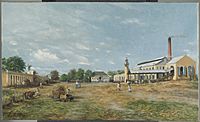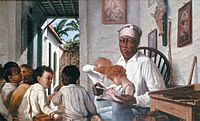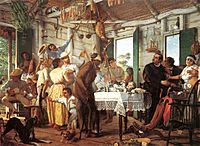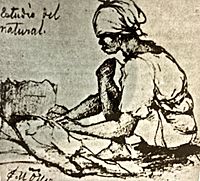Francisco Oller facts for kids
Quick facts for kids
Francisco Oller
|
|
|---|---|
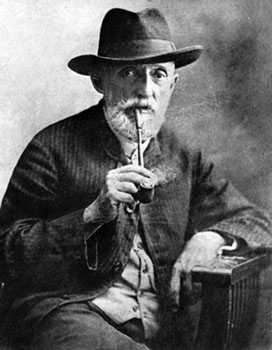
Francisco Oller
|
|
| Born |
Francisco Manuel Oller Cestero
June 17, 1833 |
| Died | May 17, 1917 (aged 83) |
| Nationality | Puerto Rican |
| Education | Royal Academy of San Fernando, Thomas Couture, Gustave Courbet |
| Known for | Painting |
| Movement | Impressionism |
| Patron(s) | Museo de Arte de Ponce |
Francisco Oller (born June 17, 1833 – died May 17, 1917) was a famous Puerto Rican painter. He was the only Latin American painter to help create Impressionism. Oller was one of the most important painters of his time. He helped change painting in the Caribbean region.
Contents
Biography
Early Life and Studies
Francisco Manuel Oller y Cestero was born in Bayamón, Puerto Rico. He was the third of four children. His parents were wealthy Spanish people.
When he was eleven, Oller started studying art. His teacher was Juan Cleto Noa, a painter in San Juan, Puerto Rico. Oller showed great talent in art. In 1848, when he was fifteen, the Governor of Puerto Rico, General Juan Prim, offered Oller a chance to study in Rome. But Oller's mother felt he was too young to travel alone. So, he did not go.
When Oller was eighteen, he moved to Madrid, Spain. He studied painting at the Royal Academy of San Fernando. His teacher was Don Federico de Madrazo y Kuntz, who directed the Prado Museum.
In 1858, Oller moved to Paris, France. He studied with famous artists like Thomas Couture and Gustave Courbet. In his free time, Oller sang in local Italian operas. He often met with other artists in cafés. He also became friends with Puerto Ricans Ramón Emeterio Betances and Salvador Carbonell del Toro. These friends lived in France because of their political beliefs. In 1859, Oller's art was shown next to works by Bazille, Renoir, Monet, and Sisley.
For a short time, Paul Cézanne was one of Oller's students. By 1865, Oller was the first Puerto Rican and Hispanic Impressionist artist. In 1868, he started The Free Academy of Art of Puerto Rico.
Art Movements
Oller's paintings were a big part of history. They showed daily life and conflicts of people in and outside Puerto Rico. He spent almost twenty years in Europe. There, he worked with artists who started Impressionism. He traveled a lot and shared new art ideas. He created his own style of modern art. He also focused on social issues in the Caribbean.
During his three trips to Paris, Oller connected with Paul Cézanne. He also met Camille Pissarro, another Caribbean artist. Oller worked with other artists from the Impressionist and Post-Impressionist movements.
When Oller returned to Puerto Rico in 1866, he saw slavery. He painted several works about it. These included El negro flageado (The negro being flogged) and El castigo del negro enamorado (The punishment of the negro in love). These paintings showed the reality of slavery in Puerto Rico.
Later Years
Throughout his life, Oller was seen as one of the best artists in Puerto Rico. He was often compared to José Campeche. Campeche was known for his portraits and religious paintings.
In 1884, Oller started an art school for young women. This school later became known as the Universidad Nacional. In 1871, Spain honored Oller. They made him a member of the Caballeros de la Orden de Carlos III. This means he was part of the Knighthood of the Order of Carlos III. A year later, he became the official painter for King Amadeo I.
Oller wanted to show the real beauty of Puerto Rico. He painted its landscapes, people, and culture. You can find Oller's paintings in museums around the world. One famous museum is the Musée d'Orsay in France.
Oller died on May 17, 1917, in San Juan, Puerto Rico. He was buried at the Santa María Magdalena de Pazzis Cemetery in San Juan.
Art Styles and Influences
Oller was a very productive painter. He painted many different things. These included still-lifes, landscapes, historical events, and portraits. He was part of several art movements. These were Realism, Naturalism, and Impressionism. He is most famous for his Impressionist works.
Oller's painting style made him special. He showed Puerto Rico's beautiful tropical landscapes. He painted both rural and city scenes. He gave a realistic view of Puerto Rico. This was different from European artists. They often painted idealized, dream-like scenes of the Caribbean.
Oller focused on everything in Puerto Rico. He painted still-life pictures of plantains and bananas. He also painted historical battle scenes. His style gave a historical look at his culture through his own eyes.
Oller spent almost twenty years in Europe. He worked with the artists who started these art movements. He learned from them and used their ideas in his own art. One clear influence in his work is how he painted rural workers in Puerto Rico. He showed them in a serious, realistic way.
Oller was influenced by Barbizon school painter Jean-François Millet. This helped him show the real life of Puerto Ricans in their historical setting. In his early years, Francisco Oller learned from European painters. These included French neoclassical painter Jean Baptiste Vermay.
His main influences in his early years came from two painters. One was the Spaniard Luis Paret y Alcázar. The other, and most important, was the Puerto Rican José Campeche y Jordán. Campeche's art was a big guide for Oller when he was a young artist. Francisco Oller was compared to Campeche as one of the most important artists in his country's history. Oller not only got ideas from Campeche's work, but he also copied some of his paintings. He even lived in Campeche's old house.
Famous Paintings
- El pleito de la herencia (The Inheritance Dispute) (1854–1856)
- Retrato de Manuel Sicardó (Portrait of Manuel Sicardó) (1866–1868)
- El Estudiante (The Student) (1874)
- Las lavanderas (The Washerwomen) (1887–1888)
- Battle of Treviño (1879)
- Oller painted Colonel Juan Contreras as the main person in this battle. The battle happened on July 8, 1875. It was part of the Carlist Wars, a war in the 1800s about who would be the next king of Spain. Oller painted this during his last visit to Europe. He was the official painter for King Alfonso XII. Oller did not follow the usual rules for military paintings. Instead, he used an Impressionistic style. This helped him capture the feeling and drama of the moment. Small dabs of color blended together. This made parts of the painting look a little blurry. Oller also used lines to make you look at Colonel Contreras. The clouds, hills, and soldiers all point to him.
- La Escuela del Maestro Rafael Cordero (The School of Master Rafael Cordero) (1890–1892)
- This painting shows Rafael Cordero. He started the first school in Puerto Rico for both formerly enslaved people and their children. By the late 1820s, his school accepted boys of all races and social classes. Cordero was the only teacher. He also made cigars and cigarettes in his workshop, which was where class took place. You can see his tobacco table in the bottom right corner. The children in the painting are from different backgrounds and have different skin tones. Oller shows how important education was for everyone, no matter their race. The two children in the front, one holding an egg and one holding bread, show how different races mixed. Oller was against slavery. He showed how people accepted different races in the growing country. Cordero looks tired and worn out in the painting. But he still keeps teaching the children. The room is simple, with religious symbols on the walls. The walls are plain and cracked. Oller showed Cordero as a hero who was not always recognized.
- El Velorio (The Wake) (1893)
- This large painting is 8 by 13 feet. It was one of the few of his works that survived. Many of his other paintings were lost or badly damaged. El Velorio was not seen as the most beautiful painting. But it was shown in the Paris Salon in 1895. Oller used small, visible brush strokes. He focused on showing light and color accurately. The painting shows a wake, or "baquiné" in Puerto Rican Spanish. This is a celebration for a child who has died. The child is on a table covered with flowers. The people at the wake ignore the child. Instead, they celebrate with food, drinks, games, songs, dancing, and prayer. They believe it is a time to celebrate because the child has become an angel. The child should be sent off properly. Meanwhile, the parents are sad about losing their child. Some people are comforting the mother. Oller’s painting is a national treasure in Puerto Rico. It is not allowed to leave the Museum of History, Anthropology, and Art at the University of Puerto Rico's Río Piedras campus.
- Bodegón con piñas (Still Life with Pineapples)
- El Cesante (The Unemployed Man)
- Hacienda La Fortuna de Ponce (La Fortuna Plantation in Ponce) (1885)
- La Ceiba de Ponce (The Ceiba Tree of Ponce) (1888)
Legacy
Oller brought Realism and Impressionism to San Juan, Puerto Rico. He combined these styles with local art traditions. He changed painting in Puerto Rico and the Caribbean. Oller also helped share world events by painting them for everyone to see. Many Puerto Rican artists have followed Oller's path. These include Ramón Frade (1875-1954) and Miguel Pou (1880-1968).
The town of Cataño in Puerto Rico named a high school after him. New York City renamed a school in The Bronx P.S. Francisco Oller. There is also a Francisco Oller Library in the Escuela de Artes Plásticas (School of Plastic Arts) in San Juan. The Francisco Oller Museum is in Bayamón. Many artists, like Tomás Batista, show their work there. In Buffalo, New York, there is a Francisco Oller and Diego Rivera Museum of Art. Manuel Rivera-Ortiz and other artists have shown their work there.
Gallery
-
Hacienda La Fortuna, 1885. Brooklyn Museum
See also
 In Spanish: Francisco Oller para niños
In Spanish: Francisco Oller para niños
- List of Puerto Ricans — Painters and sculptors



